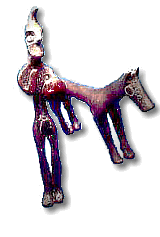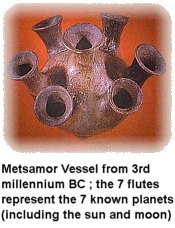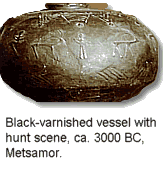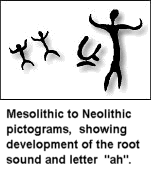Metal and Iron
 he
rise of metallurgy in the area in the Mid Bronze Age (5th-4th millenniums
BCE) saw a rapid development of cities, fortified megalithic walls and
evidence of early warfare and invasion. The unsettled history of Armenia
began eary.
he
rise of metallurgy in the area in the Mid Bronze Age (5th-4th millenniums
BCE) saw a rapid development of cities, fortified megalithic walls and
evidence of early warfare and invasion. The unsettled history of Armenia
began eary.
Echmiadzin was itself the site of Bronze Age settlements, with some thought (however controversial) that as a center for early metallurgy, the ciy may have developed into a religious center based on fire and sun worhsi the Royal Palace of the Arshakuni kings, the city also hCE a large military contingent of the kings and nobles army which was housed in barracks of the city.
By the Copper-Bronze Age (5000 - 2000 BCE), pictograms at Metsamor and the Geghama Lehr record ever more sophisticated celestial iconography, including the signs of the zodiac. Two observatories found in Armenia show a developed awareness of astronomy at least around 2800 BCE, and possibly as early as the 5th millennium BCE. Using astronomy, Ancestral Armenians developed a calendar based on 365 days, one of the first compasses, and were able to envision the shape of the world as round. The appearance of the signs of the zodiac in Armenia occurred before the Hittite and Babylonian kingdoms, which were heretofore credited with developing astronomy.
The successful smelting of bronze (along with gold, silver and magnesium) and the mining of precious gems transformed the agrarian civilization in Armenia into to an urban one: the first signs of fortified cities are traced to this era: Metsamor (which shows signs of settlement as early as 7000 BCE), Dari Blur (Armavir), Aratashen Blur, AdaBlur and Teghut. All in the immediate vicinity of Echmiadzin, which was also a developed settlement by this time.
In the 4th millennium BCE the cyclopic walls of Lechashen have been erected by Lake Sevan, while in the Ararat valley cities at Shengavit, Aigevan and Aigeshat were established. By 3000 BCE a large kingdom was established around Metsamor with additional cities at MokhraBlur, Jerahovit, Lejapi Blur, Voski Blur (Voski means "golden" in Armenian), and a settlement now known as Echmiadzin.
Shengavit is distinct among the cities in Armenia for its use of round shaped dwellings made from river stones and mud brick. The artifacts found at Shengavit (ca. 6000-4000 BCE) include black-varnished, red and gray pottery, in geometric patterns similar to those found later in the Minoan culture.
Certainly in Echmiadzin proper, fire pits and what are thought to be temple objects have been uncovered in and around the cathredral area. The fire pit under the main altar is a zoroastrian (5th c. AD) reconstruction of a much earlier pit (mid to early Bronze Age), which used fire as a worship focus, or as part of a ritual to worship/sacrifice to early deities.
The Indo-Europeans
The Armenian language is part of the Indo-European language family. The name ‘Indo-European’ is itself a variation of ‘Indo-Aryan’, and encompasses Sanskrit, Slavic, Germanic and Romance languages, and take in more territory, speaking wise, than any other on earth.
One of the greatest evolutions in history occurred when Indo-Europeans began to migrate throughout Asia and Europe. Classical historians put this event sometime in the 3rd millennium BCEand thought the source for Indo-Europeans were someplace in Central Asia. New studies place the source of the Indo-European culture on or near the Armenian Plateau, with migrations into Asia and Europe beginning as early as 7,000 BCE.
Moving first into Central Asia and India in the East, the Balkans and Europe in the West, successive waves of Indo-Europeans culminated in a ca. 2000 BCE migration into the Eastern Mediterranean which hallmarks the beginning of the Greek Doric culture.<FONT face=Verdana>
Around 2000 BCE, a second wave of Indo-European migration began, this time coming full circle back to the Armenian plateau. Thousands of years of development created distinct dialects and physical attributes, which further influenced the "mother tribes" in Armenia. Among them were the Hittites, which entered the region of Asia Minor around 2000 BCE.
Another wave of Indo-Europeans entered the scene around the 12th c. BCE, by a race called "the people of the sea". These are thought to be Thraco-Phrygians retreating from Mycanaeans and early Greek incursions in Thrace and Phrygia, probably survivors of the Trojan War, which occurred at the same time. First inhabiting the land immediately East of the Trojan kingdom in Asia Minor, the Thraco-Phrygians settled on the Western edges of the Armenian plateau and intermingled with the Haiassa-Aza, further developing Indo-European language, culture and physical features
History 2




